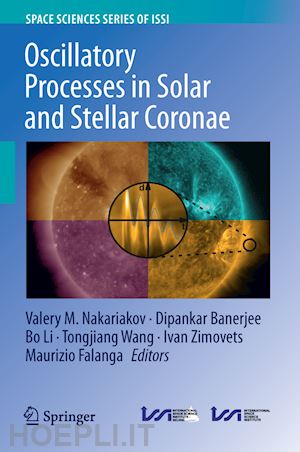
Questo prodotto usufruisce delle SPEDIZIONI GRATIS
selezionando l'opzione Corriere Veloce in fase di ordine.
Pagabile anche con Carta della cultura giovani e del merito, 18App Bonus Cultura e Carta del Docente
00 Editorial / Preface (book) (Editors: Nakariakov, V.M., et al.).- 01 MHD waves in open coronal structures (Banerjee, D., et al.).- 02 Kink oscillations of coronal loops (Nakariakov, V.M., et al.).- 03 Slow-Mode Magnetoacoustic Waves in Coronal Loops (Wang, T., et al.).- 04 Magnetohydrodynamic Fast Sausage Waves in the Solar Corona (Li, B. et al.,).- 05 Coronal heating by MHD waves (Van Doorsselaere, T., et al.).- 06 Quasi-periodic pulsations in solar and stellar flares: a review of underpinning physical mechanisms and their predicted observational signatures (Zimovets, I.V., et al.).- 07 Novel data analysis techniques in coronal seismology (Anfinogentov, S., et al.).
Professor Valery M Nakariakov graduated from the School of Radiophysics of Lobachevsky’s Gorky (now – Nizhny Novgorod) State University in 1989. He defended his PhD thesis in Plasma Physics at the Applied Physics Institute of RAS in 1993. The topic of his PhD research was theoretical modelling of the interaction of waves with plasma non-uniformities. In 1995-1999 he was a postdoc at the University of St Andrews, UK. In 1999, he became Lecturer (Full Professor from 2007) and Head of the Solar Physics team in the Physics Department of the University of Warwick, UK. His main area of research is related to the observational study and theoretical modelling of magnetohydrodynamic waves in plasma structures on the Sun's Corona, new methods of plasma diagnostics, radiophysics of the Sun, and quasi-periodic processes in solar and stellar flares. From 2011-2014, he served as President of the European Solar Physics Division of the European Physical Society. In 2015, he was honored by the Payne-Gaposchkin Medal and Prize of the Institute of Physics, UK.
Prof. Dipankar Banerjee is currently the director of the Aryabhatta Research Institute of Observational Sciences (ARIES), Nainital. He is an astrophysicist with a bachelor’s degree in physics (St. Xavier’s college) and master’s degree in theoretical physics from University of Kolkata, India. He has obtained his PhD from Indian Institute of Astrophysics and completed two postdoctoral tenures in reputed institutions in Europe. He is the co-chair of the Science working group of the “Aditya” mission. Aditya is the first dedicated Indian mission to study the Sun, expected to be launched by ISRO around 2022. He is also the project coordinator for the National Large-Solar Telescope Project (NLST). NLST is a proposed 2-meter ground-based telescope planned to be installed at a Himalayan site. He is also involved with NASA’s PUNCH mission. Dr. Banerjee has more than 120 peer-reviewed publications witharound 3000 Citations in international journals. He is currently supervising 6 PhD students while 11 of his students have completed their PhDs.
Dr. Bo Li received his BSc in Nuclear Physics and Technology from the University of Science and Technology of China (USTC) in 1996. He went on to pursue his post-graduate study in Space Physics at the same institution and received his PhD in Geophysics in 2001; the thesis being on magnetohydrodynamic waves in the highly inhomogeneous chromosphere and corona of the Sun. From 2002 to early 2009 he was a research assistant in Aberystwyth University, UK. Since 2009, he has been a professor at the School of Space Science and Physics of Shandong University in Weihai, China. Bo Li’s current research interests are primarily with low-frequency waves and oscillations in the solar atmosphere and in a broad context, solar atmospheric seismology. He has extensive experience in multi-fluid modeling of the solar wind as well; paying special attention tothe role of hydromagnetic waves/turbulence in wind heating and acceleration.











Il sito utilizza cookie ed altri strumenti di tracciamento che raccolgono informazioni dal dispositivo dell’utente. Oltre ai cookie tecnici ed analitici aggregati, strettamente necessari per il funzionamento di questo sito web, previo consenso dell’utente possono essere installati cookie di profilazione e marketing e cookie dei social media. Cliccando su “Accetto tutti i cookie” saranno attivate tutte le categorie di cookie. Per accettare solo deterninate categorie di cookie, cliccare invece su “Impostazioni cookie”. Chiudendo il banner o continuando a navigare saranno installati solo cookie tecnici. Per maggiori dettagli, consultare la Cookie Policy.